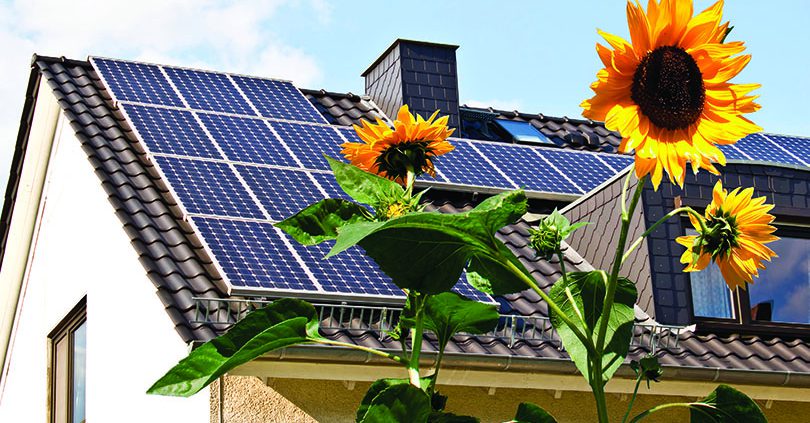Solar Energy Heats Up
By Paul Wesslund
Solar energy is really heating up. Use of photovoltaic cells to make electricity grew 30 percent each of the last two years. Experts expect that pace to continue because of falling prices for solar equipment and December’s three-year extension of federal tax credits for solar energy.
As with any new and booming technology, solar brings promise and problems. On the upside, making electricity from sunlight would seem to solve the need for energy. But the sun doesn’t shine all the time we want power, the equipment can be expensive and the nation’s electricity transmission system was not designed for the widespread use of solar energy.
“We’ve seen very quick growth already,” says Andrew Cotter, program and product manager for renewable and distributed generation at the National Rural Electric Cooperative Association. “And we’re going to see more of it.”
Electric co-ops are among the leaders in testing how community solar technology will work in the real world.
“The consumer-owned cooperative business model is promoting the growth of solar,” says Tracy Warren, senior communications manager at NRECA. “Co-ops are getting involved in solar energy because their members are asking them about it.”
The country will need more solar. U.S. energy experts say we will not be able to meet national energy goals — achieving energy independence and meeting new requirements connected to the government’s Clean Power Plan — unless we increase our solar energy capacity.
Now before you start thinking that solar power is taking over, you should know that the huge growth in solar energy starts from a small number; even with the explosion of the past few years, solar energy still generates less than 1 percent of the nation’s electricity. It will take many years of equally strong growth to even get near the portions of electricity generated nationally by wind and other non-solar renewable energy (6 percent), hydroelectric power (6 percent), nuclear (19 percent) or coal and natural gas (about 33 percent each).
The basic way that solar energy works is that when light hits certain specially-designed materials, it releases electrons from the material’s atoms, and electricity is really nothing more than flowing electrons. When these materials are manufactured into photovoltaic cells and connected, they can produce enough electricity to power a calculator, a lightbulb, a house or even several houses.
The recent growth of solar is happening in three different ways. One is utility-scale solar — large banks of photovoltaic panels that produce enough electricity for thousands of homes or businesses. Tri-State Generation and Transmission Association, which supplies electricity to 18 of Colorado’s 22 electric co-ops, buys power from the 30-megawatt Cimarron Solar Facility for its members. When it was built, it was the largest facility of its kind.
A second growth area is community solar. United Power, an electric co-op in Brighton, pioneered this concept back in 2009 when it built a solar power facility. Interested United Power members bought a share of the electricity the solar farm produced. Now 13 of the state’s 22 electric co-ops have similar community solar facilities and more co-ops will be adding them in the near future.
The third solar category goes by the fancy term “distributed generation.” That just means that the nature of solar cells can be made in lots of different sizes that can be distributed to make electricity from a lot of different places, from a little cell that powers a handheld calculator to a panel the size of a tabletop that could operate a remote water well on a cattle ranch, without the expense of building a long-distance power line.
Rooftop solar is an increasingly popular kind of distributed generation that allows homeowners to set up a bank of solar cells on their rooftops. Rooftop solar raises some of the trickiest issues for this developing source of electricity.
One of those issues comes from home solar energy owners selling excess electricity back to the utility. Designing those reverse rates can be complicated, since they need to account for a lot of factors, including the homeowner’s need for electricity all the time, not just when the solar panels are working.
Other technical issues include safety. Lineworkers repairing what they expect is a de-energized line can’t afford to be surprised by home solar panels suddenly sending electricity back through the wires.
“There is a whole new set of safety protocols and best practices that are being developed,” Cotter says. “When home solar generation becomes part of the electric grid, it is plugging into what has been called the most complex machine in the world.”
Another area of caution involves the cost and financing. The popularity of rooftop solar created an industry of vendors making a variety of claims in their sales pitches. Cotter advises people to be smart shoppers, read the fine print and get advice from your local electric co-op. He especially advises asking whether the homeowner or the vendor is getting the benefits of the renewable energy credits known as RECs.
“Electricity is a commodity; it is all the same whether it comes from a photovoltaic system or a power plant,” Cotter says.
Cotter also says some of the claims for how soon the solar project will pay for itself are based on unrealistic projections of how much electric rates will increase in the future. “Keep an eye out for any claims higher than 2 to 3 percent per year,” Cotter says. “Every utility is different, and members interested in solar energy for their home should look to their local electric co-op as the first source of trusted information.”
Paul Wesslund writes on cooperative issues for the National Rural Electric Cooperative Association.



